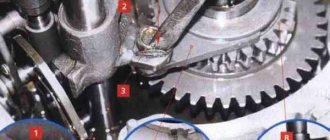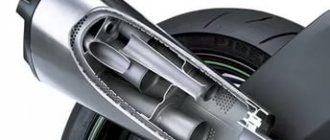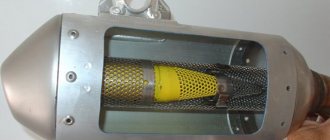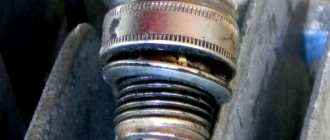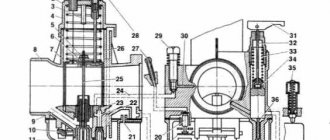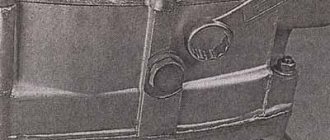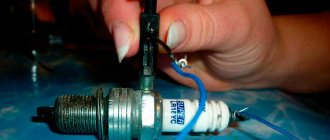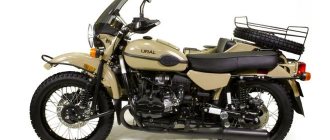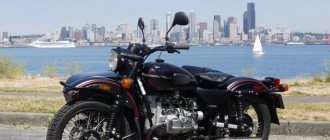On domestic motorcycles, a problem often arises associated with the appearance of loud sounds in the muffler. Even drivers of foreign vehicles often suffer from “machine gun bursts” that accompany a sharp increase or decrease in speed. Getting rid of this trouble can be quite difficult. However, if you understand why a motorcycle shoots its muffler, you can eliminate loud noises that disturb public peace.
Popping sounds in the scooter carburetor - the main reasons
You can often notice popping noises coming from the carburetor, which may indicate a violation of the mixture formation and some problems with ignition. In any case, for normal operation of the scooter engine, the problem must be eliminated. Let's look at all the reasons in more detail.
Why do popping noises appear in a scooter carburetor?
So, we started the scooter, started adding gas and heard popping noises in the carburetor. Note that we are not talking about the exhaust pipe.
Popping noises in a scooter's carburetor usually indicate a lean mixture. Why did the mixture become lean suddenly, with the engine running normally? There may also be two reasons for this.
- The first, and most common, is clogging of the carburetor, as a result of which air is supplied in the same amount, but much less gasoline, since the channel or nozzle is already blocked, although not completely, but still. Testing this theory is quite simple: close the inlet of the air filter by half the diameter. If after this the claps stop or become less intrusive, the reason for the depletion is obvious.
- Another reason for a lean mixture in this case is air leaks. Additional air can pass through the connection of the pipe with the carburetor and damage the integrity of the pipe or filter. This theory is tested in the same way as with a clogged carburetor, the effect is the same.
- The second reason for popping noises in a scooter’s carburetor is early ignition. Since the ignition on modern scooters is not regulated, this phenomenon is extremely rare, but it still occurs.
Knowing these main causes of popping noises in a scooter’s carburetor, you can correct the breakdown in a timely manner and prevent further malfunctions due to a lean mixture. And this, as a rule, means overheating of the engine and much more serious malfunctions, including jamming of the piston in the cylinder.
You can also read other articles on the topic:
The problem is common! The carbs are K-68u. This is why the right cylinder shoots into the carburetor. But the shooting is strange! You give it gas, it seems like it’s not noticeable, it rips, it works, but if you put it on the foot and engage 4th gear, pick up a speed of 50-40 km/h, approximately, turning off the right pot, the left one works like clockwork without interruption, and when the left one takes off the candlestick , then the right one starts shooting at the carb, but trying to gain speed and the pops are not strong, but because of this it doesn’t pick up speed right away, and it turns out that at the beginning when you accelerate, not much resonance is created, but at traction and at speed it is, of course, very good you can feel it! I tried the ignition, it doesn't help! Valves are adjusted! But I didn’t check for them to pass through! I tried setting the jets to 125 and 165, no change! I changed the diffuser tubes from 165 to 178! The needle was raised and lowered! The fuel screw was changed (screwed in, unscrewed). Write.
More precisely adjust the synchronization of the carburetors.
Instead of chewing the ignition, it would be logical to do something that has not yet been attempted, namely:
yes, I will need to unhook the cradle to remove the head and immediately change the head gasket! But not because of this. It’s better to ask who has encountered it))))
and synchronicity. I can’t achieve synchronization because it shoots into the carb.
Then think about what might cause the shooting, you are closer there. Put back all the old jets that you removed. The caburators must be the same.
The main reasons for shots in the carburetor
The reasons for the breakdown differ for each case. To accurately identify them, it is necessary to carry out a number of diagnostic measures. The power plant shoots into the carburetor when:
- Incorrectly selected air-fuel mixture.
- Irregularities in the ignition system.
- Incorrect operation of the gas distribution mechanism.
To identify a breakdown, no specialized education or experience in car repair is required. A sign is the presence of shots in the air filter area. When the car moves, jerks and dips are observed.
Lean air-fuel mixture
Correct operation of the power plant depends on the correct mixture of gasoline and air. If an insufficient amount of fuel is supplied, a lean mixture enters the combustion chambers.
When the piston of an internal combustion engine moves to top dead center, both valves are closed. Compression and ignition of the mixture occurs. If there is not enough fuel, it continues to burn until the suction stroke. Once the intake valve opens, the fuel in the intake manifold ignites. The rapid ignition of gasoline causes it to shoot into the carburetor.
There are several reasons why a lean mixture is formed:
- The main dosing system nozzle is clogged. Gasoline from the float chamber does not flow into the emulsion well.
- Emulsion tube clogged.
- Damage to the integrity of the accelerator pump diaphragm or piston. A sharp press on the accelerator pedal causes the throttle valve to open. Fuel from the main metering system sprayer arrives late.
- Insufficient level in the float chamber.
To eliminate the malfunction, you will need to clean the device and set the level to the correct level. Motorists use specialized cleaners. To clean, you need to remove the air filter cover. After this, start the unit and direct the aerosol stream into the working chambers.
The cleaner removes light stains. Complete disassembly of the unit may be required.
Damage to the ignition distributor cap
If the engine shoots into the carburetor, the cause may be an untimely spark supply. It slips between adjacent contacts when cracks appear in the distributor cover. This is how a spark is supplied to the spark plug when fuel is sucked from the carburetor. When gasoline ignites, it shoots into the carburetor.
In some cases, shots are observed when the distributor cap gets wet. The malfunction can be eliminated by wiping with a dry cloth.
Damage to the distributor cover requires replacement of the part with a working one. Cracks are identified by inspecting the inner surface of the lid. At the site of the spark breakdown, a grayish-white stripe will be clearly visible.
Incorrect wire connection
If the armor wire is connected to the wrong cylinder, the timing of the spark will be changed. Gasoline ignites in the intake manifold. Because of this, the carburetor will shoot. The fault can be identified and eliminated by checking and installing the wires in their places.
Spark plug failure
In some cases, the spark plug produces an unstable spark. Moreover, at moments when there is no spark, fuel accumulates in the combustion chamber. After the air-fuel mixture ignites, the fuel also ignites in the intake manifold. At the same time it shoots into the carburetor.
A faulty spark plug can be identified by the presence of black shiny carbon deposits on the electrodes. Repair involves replacing the part with a working one.
Valve malfunctions
Incorrect operation of the gas distribution mechanism leads to popping noises. There are several malfunctions that cause the engine to fire:
- Valve bend. The inlet port does not close completely at the moment of compression and stroke. In this case, the air-fuel mixture formed in the carburetor ignites.
- Incorrect adjustment. The temperature gap is necessary to avoid the valve opening when metal parts heat and expand. Some motorists reduce the gap to reduce noise levels. When the power plant heats up to operating temperature, the parts expand and the valve does not close completely.
- Pusher failure. A failed pusher prevents the exhaust valve from working properly. After the power stroke, combustion products exit into the intake manifold. During this process, it shoots into the carburetor.
To identify irregularities in the operation of the gas distribution mechanism, a compression meter is used. Repair involves dismantling the cylinder head and replacing failed parts.
Switch failure
The electronic ignition system is equipped with a switch. If a part fails, the spark from the distributor is not supplied in the compression cycle. This causes the fuel in the carburetor to ignite. Repairing the switch is not practical. To fix the problem, you will need to replace the part. The procedure can be performed by a person with minimal technical knowledge.
Ignition timing violation
When igniting early, the engine begins to shoot into the carburetor. The distributor supplies a spark to the cylinder plug not at the moment of compression, but earlier. This leads to combustion of the mixture in the manifold.
You can determine the breakdown by monitoring the operation of the starter when starting the power unit. With early ignition, the starter will work under load and jerkily. To eliminate the malfunction, a later advance angle should be set.
Displacement of timing marks
Lack of synchronism in the operation of the crankshaft and camshaft leads to untimely supply of a spark to the spark plug. The piston does not work in coordination with the timing belt. Fuel may ignite when the intake valve is open.
The carburetor sneezes into the air filter on a motorcycle. A motorcycle shoots into the muffler - problem solving
In order for a motorcycle engine to start without problems and gain speed well, at least two systems must work. One of them is the ignition system, the second is the power system. Simply put, there must be a spark in the combustion chamber at the right time and fuel mixed with air must enter the cylinder in the required quantity.
So about fuel. Before setting up the power system, you need to make sure that the ignition system is configured and working as it should. Are you sure everything is fine? Then let's begin.
You need to start with candles.
They can tell you a lot.
We unscrew the spark plugs after driving along the highway for about thirty kilometers, at least at medium or higher engine speeds, and carefully inspect them. Black carbon deposits, similar to soot, indicate that there is not enough air for the mixture to burn normally. The mixture is rich. Lots of gasoline and little air. If the spark plug insulator is completely free of soot or white, then the mixture is poor. Too much air and not enough gasoline. Normal color should be sand to brick red. If the spark plug insulator is of normal color, then you shouldn’t go into the carburetor. You should be guided by the rule that the best is the enemy of the good. Read also: Tax on gift of a car between relatives
If the carburetor is rich
First of all, we inspect the air filter. It may be dirty. The air passages may also be blocked, for example, a rag has been sucked in, the air pipe is pinched, or the air damper does not open completely. We sorted out the air supply, everything is clean, free, without obstacles. Go ahead.
You can remove the carburetor, completely disassemble it, wash it, blow out all the channels, dry it and reassemble it, but complete disassembly is not always required; more often you can get by with just adjustments. But if your carburetor does not respond to the rotation of the quality adjusting screw, then disassembling and washing is simply necessary.
First of all, check the fuel level in the float chamber
. How to do it?
We start by checking the shut-off valve or, simply put, the needle. A shut-off valve that does not hold is the cause of many troubles. Including an increased level of gasoline, which leads to over-enrichment of the mixture. On carburetors K-62, K-63, K-65, K-68, needle valves come in two types. With a ring or a rubber cone. To get to it, you need to remove the bottom cover of the carburetor, which is attached to the body with two screws (be careful when removing, do not damage the gasket), then remove the float, carefully pushing its axis out of the guides. The needle, as a rule, remains on the float tongue or falls out. Be careful not to lose it.
We inspect the needle, if it has a rubber cone, then we inspect the cone, it should be free of damage and foreign objects (hairs, grains of sand, etc.). If the needle has an o-ring, then look at how this ring sits on the head of the needle. If the ring is loose or missing altogether, it is necessary to replace (install) either only the o-ring or the needle. The ring should fit tightly. The needle must move along the seat without jamming, otherwise we replace the entire valve.
With the carburetor removed, you can check the level like this.
We turn the carburetor over with the float up and measure the distance from the plane of the body to the very top of the float. It should be within 26-27 mm. If it does not match, then adjust the size by bending the float tongue.
Is it possible to check and adjust the fuel level without removing carburetors in the Urals? Are they installed on the cylinder heads at angles to the horizontal and vertical planes?
With some skill this is possible. To do this, you will need a free float from the same carburetor. In a motorcycle mounted on the central stand (we are talking about a single motorcycle), open the gas tap. We wait a while for the carburetors to fill with gasoline. Close the gas valve and disconnect the gas hose from the carburetor. Remove the bottom cap of the carburetor with gasoline and lower the spare float into it. Next, we lean the lid against the lower plane of the body so that the planes of the lid become a continuation of the plane of the body (we simulate the installation of the lid, set the actual angle of inclination of the lower part), while the fuel level should be below the edge of the lowest corner of the lid and not overflow through it . If it does not correspond, then by bending and bending the tongue we achieve the desired level. In this case, the bottom cover and gas hose will have to be removed and replaced several times to test filling with gasoline. After adjusting the level, we proceed to the next one.
Adjusting idle speed and mixture quality (Carburetor K-62, 63, 65, 68).
We make adjustments on a warm engine. The procedure is approximately this:
1. Set the minimum stable engine speed by rotating the quantity screw (on K-62,63,65 this is the top 13mm wrench bolt, on K-68 this is a horizontal screw for a screwdriver). 2. Slowly rotating the quality screw in one direction or another (on all of the listed types of carburetors this is a vertical screw for a screwdriver), we catch the moment the speed increases to the maximum (approximately 1.5-2.5 turns from the fully tightened position, but deviations in that direction are possible or other party). 3. Repeat steps 1 and 2 until normal idle speed is established. 4. Check the adjustment by opening and closing the throttle. 5. If the engine stalls when you sharply open the throttle, turn the quality screw 1/4-1/2 turn (enrich the mixture). 6. If the engine stalls when the throttle is suddenly closed, turn out the quality screw 1/4-1/2 turn (lean the mixture).
Owners of motorcycles not only made in Russia, but also of foreign cars often face the problem of “shooting” from the muffler. This happens due to improper care of the air-fuel mixture ignition system. The motorcycle shoots the muffler in several cases:
- when using low-quality gasoline;
- malfunction of the electronics system responsible for fuel supply;
- gasoline does not enter the combustion chamber in pure form;
In such cases, you don’t need to wonder why the muffler on a motorcycle shoots. Poor quality gasoline has a very high combustion temperature due to the addition of water, so it does not ignite completely. The remaining drops fall on the walls of the heated muffler
. Their ignition creates pops.
Read also: Stop sign on demand
The motorcycle also shoots into the muffler when releasing the gas. The lower the pressure created in the internal combustion chamber, the more droplets enter the muffler. On some bikes, fuel accumulates in the muffler, followed by rare but very loud bangs.
Most often, but not always, owners of the Russian motorcycle industry face this problem. For example, a Ural motorcycle shoots into the carburetor. This occurs due to direct clogging of gasoline in the carburetor itself. To avoid this problem, it is necessary to constantly clean the filters and change the consumables responsible for cleaning the engine. Proper operation of your bike will not only ensure good engine performance, but will also maintain factory specifications.
IZh Planet motorcycle carburetor 4 malfunctions and their elimination.
Home > Service
A K62I brand carburetor is installed on the engine of the IZH Planet 4 motorcycle. Like all motorcycle components, the carburetor performs a certain most important job. The main goal is to prepare a high-quality mixture from air and fuel (gasoline) for engine operation. In what ratio this mixture will be created will depend on the operation of the engine, its power, throttle response and easy controllability of not only the engine, but also the entire motorcycle. And the fuel tap and air filter are responsible for the purity of the fuel mixture.
The carburetor consists of body 1 and two covers, upper and lower. Body 1 of the carburetor is the base on which all carburetor parts are mounted, and also inside the carburetor body, channels are drilled through which air and fuel pass; using adjusting screws and special jets in the channels, air and fuel are mixed in certain proportions.
At the bottom of the carburetor, a cover is attached with two bolts, which is the body of the float chamber. The float chamber plays a critical role in engine operation; with the help of float 6 and needle 7, it automatically regulates the fuel supply to the carburetor to a certain level, which in turn affects engine operation.
The main malfunction of the float chamber is that when the fuel tap is opened, the fuel spontaneously overflows the carburetor and flows out. First of all, we check the needle 7 for the presence of the o-ring 8 on it and its condition. Be sure to check for the presence of foreign objects in the hole where the float needle 7 is located; blow out the hole with compressed air. The operation of the float suppressor also needs to be checked; there has been a case when the tube in which the suppressor is located was displaced inside the float chamber by an impact and the suppressor touched the float. We check the float for the absence of fuel inside the float. Adjusting the level of the float chamber is practically not lost.
The next step in checking the performance of the carburetor will be idling. Idle speed is characterized by stable engine operation at low speeds and during the transition from low engine speeds to medium speeds. When the throttle is raised sharply, the transition should take place without failures in engine operation. Jet 3 for the fuel supply and adjusting screw 2 for the air supply are responsible for this work. The ratio in which the fuel mixture of these parts will be prepared will depend on the idle speed.
Idle speed problems mainly occur in the cleanliness of the idle fuel jet hole. Usually, after cleaning and purging the jet, problems with idle speed disappear. At medium and higher engine speeds, the main fuel jet 4 with metering needle 9 is activated, and the throttle valve supplies air. The fuel supply is adjusted using a metering needle 9, which has five positions and is set in one of the positions using a spring lock 10. Raising the needle increases the amount of fuel, letting it go decreases it.
Malfunctions appear when spring lock 10 wears out, needle 9 falls out and cuts off the fuel supply. The engine loses throttle response, gets very hot, and pops appear in the carburetor. The spring lock is replaced with a new one.
in the K62I carburetor of the IZH Planet 4 motorcycle. Its main purpose is to prepare a higher quality enriched fuel mixture for starting a cold engine. Which is controlled using a coin enricher installed on the steering wheel.
Similar articles:
- Equipment for the power supply system of the Planet 4 motorcycle
top of page
What do the shots affect?
Problems with the ignition system do not bode well. In such a situation, with prolonged engine operation, not only the aesthetic impression can deteriorate. A dirty carburetor or low-quality fuel will eventually disrupt cylinder compression, which in turn will lead to engine failure.
To understand why a Ural motorcycle shoots at the muffler, or any other bike, you should check the problem areas. Here are possible ones:
- not tightness of the pipes that can suck in air, or the exhaust tract;
- faulty spark plugs;
- dirty air filters or carburetor;
- difficulty in supplying fuel;
However, the problem may also be with the racers' rev limiter. The spark plugs do not charge continuously, causing most of the mixture to go straight into the exhaust system, where it hits the hot metal and ignites, creating a loud bang. A clear example of such a process is a motorcycle equipped for special show programs. On such bikes, some of the fuel mixture ignites directly in the exhaust pipe, which is why you can see a flame coming out of the muffler.
Under no circumstances should you install direct flow
if you experience popping noises. This will only increase the noise in the exhaust system. This happens due to an even greater depletion of the fuel-air mixture and a “gutted” muffler.
On domestic motorcycles, a problem often arises associated with the appearance of loud sounds in the muffler. Even drivers of foreign vehicles often suffer from “machine gun bursts” that accompany a sharp increase or decrease in speed. Getting rid of this trouble can be quite difficult. However, if you understand why a motorcycle shoots its muffler, you can eliminate loud noises that disturb public peace.
The reason is the ignition
Ignition of the working mixture
When the damper is opened sharply, if the ignition timing is not precisely set, i.e. If there is early ignition, then it is felt like cotton in the air filter. Please note: the working mixture is formed in the intake manifold and if the intake valve is open, this liquid ignites not only inside the cylinder, it ignites throughout the entire manifold - this is very bad for the engine. The reasons why cotton occurs are as follows:
- Old candles - see if there is carbon deposits on the candles. Replace with new ones if necessary. Please note: special spark plugs have been developed for gas vehicles; they last longer than usual. If, when replacing spark plugs, lubricant is visible in the well, replace the valve cover gasket. Otherwise, the oil will lead to failure of the spark plugs, explosive wires or coil.
- The valve does not fit tightly due to carbon deposits. Untimely ignition leads to incomplete combustion of the fuel, and a large amount of soot is formed.
- Burnt out valve. With such a breakdown, the car should fire even at idle speed.
- The ignition angle is not adjusted. Check the vehicle dealer's recommendations or contact a service center.
- Use of low-quality fuel.
- Wear, short circuit of explosive wires, incorrect connection. Usually the spark plugs are checked first. If replacing them does not help and the car continues to fire, look at the explosive wires. You can determine where the high voltage goes at night with the engine running and revving up.
The essence of the problem
Most often, loud pops in the muffler are heard when a lean mixture is supplied to the engine. The reason for its formation may be the use of low-quality gasoline, saturated with water and non-flammable impurities, or incorrect adjustment of the intake system. The air-fuel mixture burns only partially - its remains splash out into the hot muffler, where they explode with sharp, unpleasant sounds. A symptom of a lean mixture is popping sounds in bursts, which intensify as the speed increases.
In powerful motorcycles, the completely opposite problem is more common, associated with the supply of an excessively rich mixture. There is not enough oxygen for its combustion, which leads to the deposition of gasoline condensate on the walls of the muffler. When the “critical mass” is reached, the fuel outside the engine ignites, resulting in one loud bang. If the problem is not corrected, within 1-2 months the contents of the muffler will simply burn out and it will turn into a “direct flow”.
Incomplete combustion of the mixture may be caused by a malfunction of the ignition system. In the absence of a spark, the cylinder misses a power stroke and the full amount of gasoline enters the muffler. Loud sounds are most often heard in this case at high speeds. The problem is also fraught with complete burnout of the muffler from the inside. Misfires are often accompanied by beautiful visual effects - when the engine is overloaded, jets of flame fly out of the exhaust pipes.
Another option is a lean mixture in the intake system caused by air, dirt or water getting into it. Naturally, the fuel does not burn completely and drops of gasoline form on the walls of the muffler, burning with a sharp, characteristic sound. In any case, the motorcycle malfunction must be repaired as soon as possible so as not to encounter more serious repairs.
Solenoid valve malfunction
HBO element on an injection car.
Detonation of the mixture during combustion leads to the appearance of a characteristic sound, indicating a clogged nozzle. If the degree of contamination is large, then the pops are very obvious; with minor contamination, the pops are barely noticeable. This problem is accompanied by an increase in fuel consumption and a decrease in the acceleration dynamics of the car. Take a closer look at the exhaust gases, they become very caustic, and as the condition of the valve deteriorates, the color of the exhaust becomes darker.
There is one way to fix the problem: wash the nozzles to remove carbon deposits. The use of chemicals with a high concentration of solvent makes it possible to remove heavy carbon deposits from valves and combustion chamber elements.
The cause of the popping sound when you press the gas pedal sharply may be a lean fuel mixture. It is formed if the gas in the cylinder is almost running out. In such a situation, a popping noise occurs even with a fully functional car.
We recommend watching a video about solving the problem of popping sounds on second-generation LPG:
Reason and solution
The easiest way to get rid of pops on a carburetor motorcycle is to simply move the needle valve to a different position, changing the degree of saturation of the mixture with gasoline. It is better to entrust this operation to a specialist, since not everyone can fine-tune the carburetor. If there is electronic fuel injection, it is impossible to change the gasoline supply parameters yourself - the control unit will have to be flashed at a specialized service station.
It happens that the motorcycle shoots into the muffler and carburetor - this is often found on domestic Urals and imported choppers with a large cylinder capacity. The problem is a clogged air-fuel mixture at the inlet. To eliminate it, it is worth changing the filters and sealing gaskets, and also checking how tightly the pipes fit to the inlet fittings and whether there are any large cracks in them.
Read also: Wires for PTF Polo sedan
Very often, popping noises appear after the muffler is replaced with a non-standard one or holes are cut out in it to eliminate resistance to the escaping exhaust gases. Particularly unpleasant sounds appear when installing a “direct flow”. The reason is the creation of a strong vacuum, which leads to a lean air-fuel mixture. Powerful imported motorcycles often use an exhaust gas afterburning system, which reduces their toxicity - after removing the standard muffler, its operation becomes clearly audible. To eliminate shots after changing the silencer, you must:
- Reconfigure the carburetor or reflash the control unit;
- Install filters with a different capacity;
- Disable the exhaust gas afterburning system.
For engines whose engines operate at high speeds, the problem with shots may be associated with the speed limiter or crankshaft speed limiter. When a certain indicator is reached, the fuel supply may remain unchanged for some time, while the number of flares is reduced. Accordingly, a huge amount of gasoline enters the muffler, which explodes with a jerky sound, forming a “machine gun burst.” It can be heard especially well when releasing the gas after active acceleration. It is impossible to eliminate such a problem without reducing the life of the engine - you have to change your driving style so as not to irritate yourself and others with unpleasant loud bangs.
It is worth paying attention - skipping flashes may be due to its malfunction. Carefully inspect the high-voltage wires - there should be no cracks or peeling of the insulation on them. After unscrewing the spark plugs, check to see if there is a specific deposit on their surface that appears when using low-quality gasoline or when the ignition timing is set incorrectly. If the motorcycle is equipped with an electronic ignition system, the problem can often be solved by reprogramming the control unit. Some motorcycle owners decide to make drastic changes by installing a new control unit with preset sport settings - this solves the problem of shots in the muffler, and also increases engine power and improves dynamic characteristics.
Quick diagnostics
Since in the future the problem of popping noises in the muffler can lead to breakdown of the engine and other important components of the motorcycle, it needs to be solved as quickly as possible. You should consistently check the performance of systems such as: intake, ignition, exhaust. All damaged parts are replaced with new ones, connections are sealed. It is also better to temporarily replace tuning components with “stock” ones to check how the engine will perform with factory settings. If all else fails, the motorcycle should be inspected by a professional mechanic, who will find the cause and tell you how to eliminate it at minimal cost and without reducing the life of the power unit.
We welcome every motorbike enthusiast! The “Questions and Answers” section was created for informational purposes. Each of you should know why his iron horse has certain problems in operation.
Many of you will be interested to know why the motorcycle shoots. There is no need to wait until this trouble appears. Find out how to protect your steel horse.
Often the bike makes sounds that remind us of sneezing or gunshots. This is quite strange, but understandable. This problem affects not only the much-criticized motorcycles of the USSR. A similar oddity can occur when using vaunted foreign motorcycles.
The reasons for the firing of motorcycle equipment can be associated solely with the process of ignition of the fuel mixture in the cylinders of the iron horse. If the electronics system is not configured correctly or gasoline is not supplied to the internal combustion chamber in its pure form, you should not wonder why the motorcycle is firing. Both Soviet bikes and foreign steel horses do not tolerate low-quality gasoline. If the latter contains an excessive amount of water, the iron horse, as usual, makes dull hissing sounds that resemble “CHHI.”
If there is a problem in the ignition system (the advance is knocked down, for example, on the contacts), motorcycle equipment also does a poor job of burning fuel, as in the case of poor quality fuel).
Instead of asking yourself the above question, ask yourself how it is possible to maintain such a bad ignition system on a two/three wheeler or put bad fuel into it. Yes, gasoline that is of excellent quality can become clogged directly in the carburetor of your bike. Cleaning filters to avoid such a nuisance or buying new consumables of this type is a mandatory norm for modern operation of the iron horse!
A motorcycle sneezes for a reason. Its systems resemble the human body. If the latter is also not in order, it produces strange defensive actions.
